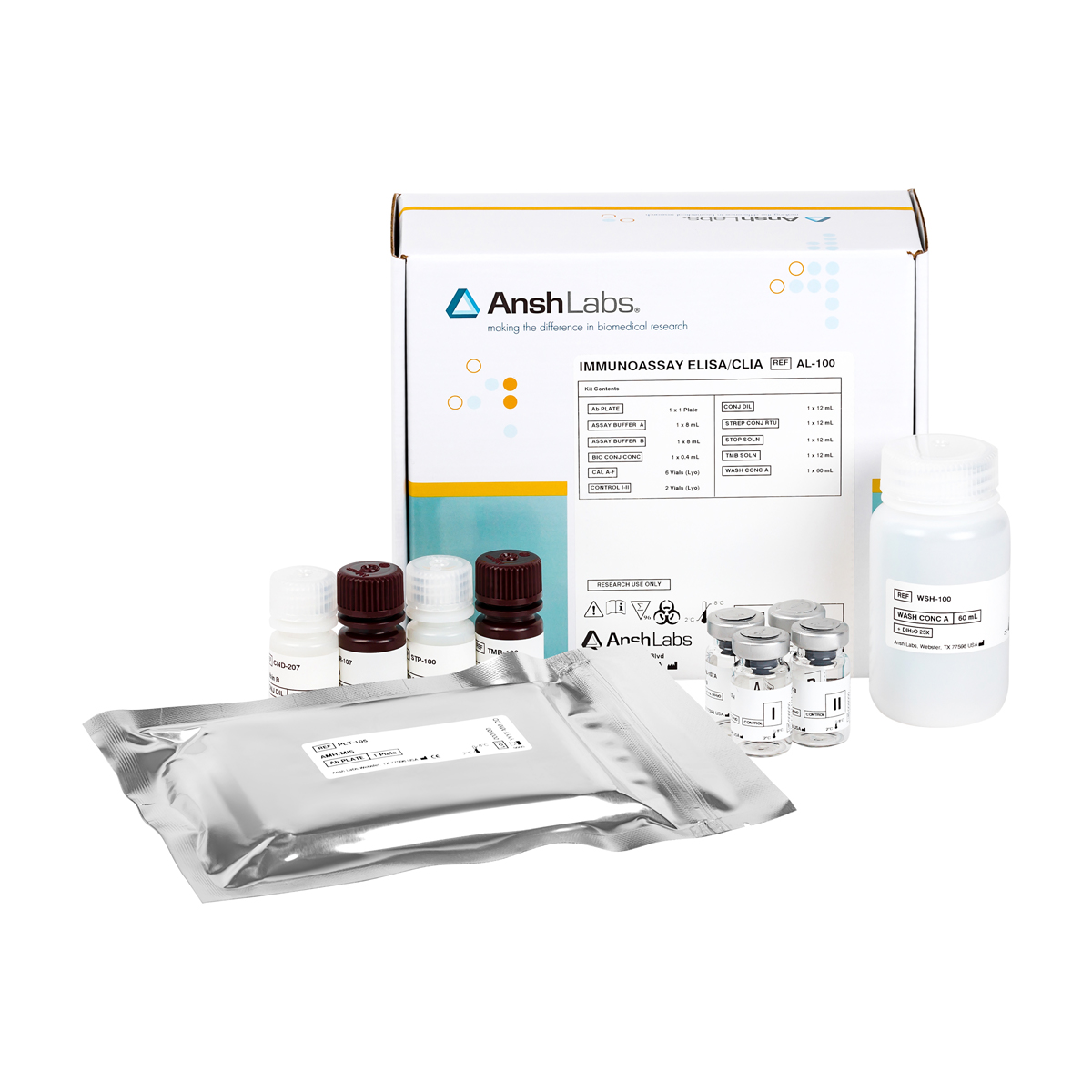The Canine/Feline Anti-Müllerian hormone (AMH) enzyme-linked immunosorbent assay (ELISA) kit provides materials for the quantitative measurement of AMH in Canine and Feline serum. The test is intended to be used as a diagnostic tool in the determination of functional gonadal (spayed, neutered, or intact) status in dogs and cats.
| Catalog Number | |
|---|---|
| Packaging | 96 well microtiter |
| Detection | HRP-based ELISA, colorimetric detection by dual wavelength absorbance at 450 nm and 630 nm as reference filter |
| Dynamic Range | 2, 0.3-11.9 ng/mL |
| Limit of Detection | 0.015 ng/mL |
| Sample Size | 25 µL |
| Sample Type | Serum |
| Assay Time | 3.5 hours |
| Shelf Life | 24 months |
| Species Reactivity | Canine Serum, Feline Serum |
| Availability | Worldwide |
Anti-Müllerian hormone is a 140 kDa glycoprotein that is produced during normal embryogenesis by the Sertoli cells of the embryonic testis, causes the involution of the Müllerian duct, and inhibits female gonadogenesis by inducing apoptosis of target gonadal cells. It belongs to the transforming growth factor-β super family. AMH causes apoptosis of specific Anti-Müllerian inhibiting substance (MIS) receptor-bearing cells, while having no effect on cells without receptors. AMH is also expressed in granulosa cells of preantral and small antral follicles in the ovary, and AMH inhibits recruitment of primordial follicles into the pool of growing follicles, and decreases responsiveness of growing follicles to FSH.
References:
1. HHS Publication, 5th ed., 2007. Biosafety in Microbiological and Biomedical Laboratories. Available http://www.cdc.gov/biosafety/publications/bmbl5/BMBL5
2. DHHS (NIOSH) Publication No. 78–127, August 1976. Current Intelligence Bulletin 13 – Explosive Azide Hazard. Available http:// www.cdc.gov/niosh.
3. Approved Guideline – Procedures for the Handling and Processing of Blood Specimens, H18-A3. 2004. Clinical and Laboratory Standards Institute.
4. Kricka L. Interferences in immunoassays – still a threat. Clin Chem 2000; 46: 1037–1038.
NOTICE – Feline Testing References:
Feline reproductive function tests. Anti-Müllerian Hormone (AMH) Test for Ovarian Remnant Syndrome, Cryptorchidism and Determination of Spayed/Castrated vs. Intact. Cornell University College of Veterinary Medicine. (2022, July 18). Retrieved March 14, 2023, from https://www.vet.cornell.edu/animal-health-diagnostic-center/testing/protocols/feline-reproductive
Anti-Mullerian Hormone Testing: Feline and Canine. UC Davis Veterinary Medicine. (2023, Jan 24). Retrieved March 14, 2023, from https://www.vetmed.ucdavis.edu/labs/endo-lab/anti-mullerian-hormone-testingvetmed.ucdavis.edu/labs/endo-lab/anti-mullerian-hormone-testing
AMH (Canine) ELISA AL-116
Chotimanukul S, Goericke-Pesch S, Suwimonteerabutr J, Singlor J, Sangkrachang E, Tummaruk P, Ponglowhapan S. Serum Anti-Müllerian Hormone Levels and Estrous Monitoring of GnRH Agonist Deslorelin-Induced Estrus in Bitches: A Pilot Study. Animals (Basel). 2023 Jan 12;13(2):258. doi: 10.3390/ani13020258. PMID: 36670799; PMCID: PMC9855037.
All Products Cited: Canine AMH ELISA AL-116
Ganz S, Wehrend A. Uptake of exogenous estrogen as a differential diagnosis of ovarian-remnant-syndrome in a bitch: a case report. BMC Vet Res. 2021 Jun 25;17(1):225. doi: 10.1186/s12917-021-02923-9. PMID: 34172052; PMCID: PMC8235845.
All Products Cited: Canine AMH ELISA AL-116
Kumar A, Kalra B, Patel A, Shah S. New Sensitive Anti-Müllerian Hormone (AMH) ELISAs for Non-Human Primate, Rodent, Equine, Bovine, Canine and Other Species. Poster session presented at: American Association for Clinical Chemistry; 2013; Jul 30-Aug 1; Houston, TX.
All Products Cited: AMH ELISA AL-105; AMH (Bovine) ELISA AL-114; AMH (Canine) ELISA AL-116; AMH (Equine and Ovine) ELISA AL-115; AMH (Rat and Mouse) ELISA AL-113
Hollinshead FK, Walker C, Hanlon DW. Determination of the normal reference interval for anti-Müllerian hormone (AMH) in bitches and use of AMH as a potential predictor of litter size. Reprod Domest Anim. 2017 Apr;52 Suppl 2:35-40.
All Products Cited: Canine AMH ELISA AL-116
Ackermann C, Kozlowski C, Callahan M, Bauman K, Clawitter H, Asa C, Lopes M. Anti- Müllerian hormone concentration in female gray wolf (Canis lupus) – preliminary results. Reproduction In Domestic Animals. Hoboken: Wiley, v. 54, p. 52-53, 2019.
All Products Cited: AMH (Canine) ELISA AL-116
Cusatti AC, Somoza R, Marchetti IA. Antimullerian Hormone (AMH) as biomarker of Granulosa Cell Tumor (GCT), case report. Abstract presented at the 20th European Veterinary Society for Small Animal Reproduction Congress, 29th June – 1st Jul 2017 Vienna Austria
All Products Cited: Canine AMH ELISA; AL-116
Holst BS. Diagnostic possibilities from a serum sample—Clinical value of new methods within small animal reproduction, with focus on anti-Müllerian hormone. Reprod Domest Anim. 2017 Apr;52 Suppl 2:303-309. doi: 10.1111/rda.12856. Epub 2016 Oct 18. PMID: 27758004.
All Products Cited: Canine AMH ELISA; AL-116
Themmen APN, Kalra B, Visser JA, Kumar A, Savjani G, Gier J, Jaques S. The use of anti-Müllerian hormone as diagnostic for gonadectomy status in dogs. Theriogenology 86 (2016) 1467–1474.
All Products Cited: AMH (Canine) ELISA AL-116; rec Hu AMH Ag AG-303-BA047
Walter B. Anti-Müllerian hormone in dogs and cats reproduction. Reprod Domest Anim. 2020 Jul;55 Suppl 2:26-31. doi: 10.1111/rda.13603. Epub 2020 Feb 7. PMID: 32031297.
All Products Cited: AMH (Canine) ELISA AL-116
Yilmaz O, Toydemir T, Kirsan I, Ucmak Z, Karacam E. Anti-Mullerian hormone as a diagnostic tool for ovarian remnant syndrome in bitches. Vet Res Commun. First published online June 24, 2015.
All Products Cited: Canine AMH ELISA AL-116
